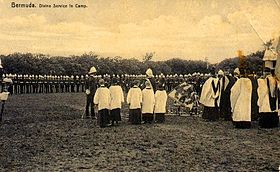Prospect Camp, Bermuda
| Prospect Camp | |
|---|---|
| Devonshire Parish, Bermuda | |

Presentation of colours at Prospect Camp
|
|
|
Location in Bermuda
|
|
| Coordinates | 32°17′58″N 64°45′55″W / 32.2994949°N 64.7653454°WCoordinates: 32°17′58″N 64°45′55″W / 32.2994949°N 64.7653454°W |
| Type | Barracks |
| Site information | |
| Owner | Ministry of Defence |
| Operator |
|
| Site history | |
| Built | circa 1850 |
| In use | 1850s-1957 |
| Garrison information | |
| Garrison | Bermuda Garrison |
Prospect Camp, also referred to as Prospect Garrison, was the main infantry camp of the Bermuda Garrison. It also contained Prospect Fort, manned by the Royal Garrison Artillery. It passed to the local government when the garrison was withdrawn in 1957.
The Bermuda Garrison was built up from the 1790s onwards, paralleling the development of the Royal Navy facilities in Bermuda. Following US independence, which cost the Royal Navy all of its continental bases between the Maritimes and Florida (the latter of which would also pass to the United States), Bermuda, located 640 miles off Cape Hatteras, North Carolina, became very important to the Royal Navy, which began buying up tracts of land around the colony. Although the West End had been identified immediately as the ideal location for a dockyard and naval base, no passage through the encircling reefs large enough to allow ships-of-the-line to access the West End, the Great Sound, and Hamilton Harbour was then known. The navy spent a dozen years charting the reefs around Bermuda in search of a passage. Meanwhile, it concentrated its establishment in St. George's Harbour, buying land in and around St. George's Town.
With most of the military fortifications built previously by the militia already clustered around the East End, as well, the British Army built up a large garrison, with headquarters and barracks, to the north of the town. Many forts, batteries and other smaller sites were scattered about Bermuda, but most of the army's manpower was in St. George's Garrison.
By 1812, the navy was developing the new Royal Navy Dockyard at the West End, on Ireland Island. The new town of Hamilton, located in the central parishes, and to which the colony's capital moved from St. George's in 1815, was achieving increasing prominence thanks to the same channel which allowed development of the dockyard. It became necessary to redeploy much of the military force in Bermuda westward, nearer to the new capital and the dockyard. Consequently, in the middle of the 19th century, the army purchased land on White Hill in Devonshire, and began the development of a large camp, with barracks to house the bulk of the infantry soldiers in Bermuda. Called Prospect Camp, it contained the headquarters of Bermuda's military garrison, barracks, parade grounds, training areas, and a fort. Prospect Fort was manned by the garrison units of the Royal Regiment of Artillery, later known as the Royal Garrison Artillery (this was one of three forts whose coastal artillery was intended to complement each other's with overlapping fire to guard the shores and the overland approaches to Hamilton, the others being Fort Hamilton and Fort Langton).
...
Wikipedia

